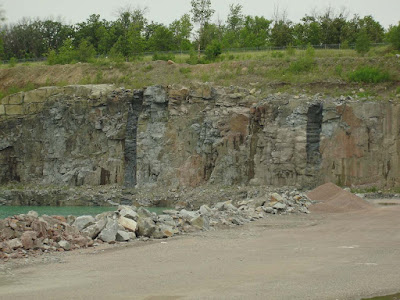The granite is quarried in the area by several companies for use as either dimension stone or aggregate. Cold Spring Granite maintains several quarries and a processing plant for decorative uses on buildings, countertops, headstones, etc. The quarry pictured here are from the Rockville Quarry #2, which is sold by the tradename Rockville White.
Located just above the granite in the area, and seen well in many quarries, are rounded boulders of granite. These are corestones. The granites in the area are jointed, weathering of the granite affect the corners of the joints first, eventually smoothing the corners and producing rounded boulders. The weathering event most likely took place during the Cretaceous, the same period which formed the kaolinite clays found in the upper Minnesota River Valley.
The region is also swarmed by many diabase intrusions. These intrusions are easily seen within the Martin Marietta aggregate quarry.
Below is a picture of me standing in front of a diabase dike intruding on a body of St. Cloud Red granite.
Because quarries are privately owned and a potential safety hazard, exploring them without guidance or permission is not allowed. Quarry Park and Nature Reserve is a public park that allows easy access to many of the features found within the granite throughout the region. Like the name suggests, the area was once home to almost 30 granite quarries.
Walking the many hiking trails within the park, it's easy to examine the relationship between the granite and diabase intrusions.
























Thank you for you explanation.
ReplyDelete